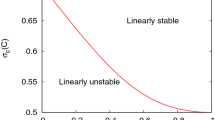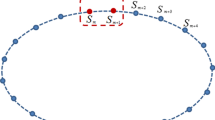Abstract
We consider a finite region of a d-dimensional lattice of nonlinear Hamiltonian rotators, where neighbouring rotators have opposite (alternated) spins and are coupled by a small potential of size \(\varepsilon ^a,\, a\ge 1/2\). We weakly stochastically perturb the system in such a way that each rotator interacts with its own stochastic thermostat with a force of order \(\varepsilon \). Then we introduce action-angle variables for the system of uncoupled rotators (\(\varepsilon = 0\)) and note that the sum of actions over all nodes is conserved by the purely Hamiltonian dynamics of the system with \(\varepsilon >0\). We investigate the limiting (as \(\varepsilon \rightarrow 0\)) dynamics of actions for solutions of the \(\varepsilon \)-perturbed system on time intervals of order \(\varepsilon ^{-1}\). It turns out that the limiting dynamics is governed by a certain autonomous (stochastic) equation for the vector of actions. This equation has a completely non-Hamiltonian nature. This is a consequence of the fact that the system of rotators with alternated spins do not have resonances of the first order. The \(\varepsilon \)-perturbed system has a unique stationary measure \(\widetilde{\mu }^\varepsilon \) and is mixing. Any limiting point of the family \(\{\widetilde{\mu }^\varepsilon \}\) of stationary measures as \(\varepsilon \rightarrow 0\) is an invariant measure of the system of uncoupled integrable rotators. There are plenty of such measures. However, it turns out that only one of them describes the limiting dynamics of the \(\varepsilon \)-perturbed system: we prove that a limiting point of \(\{\widetilde{\mu }^\varepsilon \}\) is unique, its projection to the space of actions is the unique stationary measure of the autonomous equation above, which turns out to be mixing, and its projection to the space of angles is the normalized Lebesque measure on the torus \(\mathbb {T}^N\). The results and convergences, which concern the behaviour of actions on long time intervals, are uniform in the number \(N\) of rotators. Those, concerning the stationary measures, are uniform in \(N\) in some natural cases.
Similar content being viewed by others
Notes
I.e. the this equation has a unique stationary measure, and its solutions converge weakly in distribution to this measure.
Usually, for a vector from \(\mathbb {C}^N\), denoted by the letter \(u\), we write its actions and angles as above, and for a vector, denoted by \(v\), we write them as \((J,\psi )\), \(J=J(v),\;\psi =\psi (v)\).
We can not assume that \(g_j\) is independent from \(N\) for all \(N\in \mathbb {N}\) since for small \(N\) the \(j\)-th rotator may have fewer neighbours then for large \(N\).
We recall that the weak convergence of measures is metrisable (see [12], Theorem 11.3.3), so it makes sense to talk about its uniformity.
For details see Sect. 3.1. We will fix \(\gamma \), so we do not indicate the dependence on it.
This constant is not optimal, one can improve it.
The Poisson brackets correspond to the symplectic structure \(\frac{i}{2}\sum \limits _{j\in {\mathcal {C}}}dv_j\wedge d\overline{v}_j,\) written in the action-angle coordinates.
References
Basile, G., Bernardin, C., Olla, S.: Thermal conductivity for a momentum conservative model. Commun. Math. Phys. 287, 67–98 (2009)
Basile, G., Olla, S., Spohn, H.: Energy transport in stochastically perturbed lattice dynamics. Arch. Rat. Mech. Anal. 195, 171–203 (2010)
Bernardin, C., Huveneers, F.: Small perturbation of a disordered harmonic chain by a noise and an anharmonic potential. Probab. Theory Relat. Fields 157, 301–331 (2013)
Bernardin, C., Olla, S.: Fourier’s law for a microscopic model of heat conduction. J. Statist. Phys. 118, 271–289 (2005)
Bernardin, C., Huveneers, F., Lebowitz, J.L., Liverani, C., Olla, S.: Green–Kubo formula for weakly coupled system with dynamical noise (2013). arXiv:1311.7384v1
Bernardin, C., Kannan, V., Lebowitz, J.L., Lukkarinen, J.: Harmonic systems with bulk noises. J. Statist. Phys. 146, 800–831 (2011)
Bonetto, F., Lebowitz, J.L., Lukkarinen, J.: Fourier’s law for a harmonic crystal with self-consistent stochastic reservoirs. J. Statist. Phys. 116, 783–813 (2004)
Bonetto, F., Lebowitz, J.L., Rey-Bellet, L.: Fourier’s law: a challenge to theorists. In: Mathematical Physics, pp. 128–150. Imperial College Press, London (2000)
Bonetto, F., Lebowitz, J.L., Lukkarinen, J., Olla, S.: Heat conduction and entropy production in anharmonic crystals with self-consistent stochastic reservoirs. J. Statist. Phys. 134, 1097–1119 (2009)
Da Prato, G., Zabczyk, J.: Ergodicity for Infinite Dimensional Systems. Cambridge University Press, Cambridge (1996)
Dolgopyat, D., Liverani, C.: Energy transfer in a fast-slow Hamiltonian system. Commun. Math. Phys. 308, 201–225 (2011)
Dudley, R.M.: Real Analysis and Probability. Cambridge University Press, Cambridge (2002)
Dymov, A.V.: Dissipative effects in a linear Lagrangian system with infinitely many degrees of freedom. Izv. Math. 76(6), 1116–1149 (2012)
Dymov, A.: Statistical mechanics of nonequilibrium systems of rotators with alternated spins (2014). arXiv:1403.1219
Eckmann, J.-P., Pillet, C.-A., Rey-Bellet, L.: Non-equilibrium statistical mechanics of anharmonic chains coupled to two heat baths at different temperatures. Commun. Math. Phys. 201, 657–697 (1999)
Freidlin, M., Wentzell, A.: Averaging principle for stochastic perturbations of multifrequency systems. Stoch. Dyn. 3, 393–408 (2003)
Freidlin, M.I., Wentzell, A.D.: Long-time behavior of weakly coupled oscillators. J. Statist. Phys. 123, 1311–1337 (2006)
Freidlin, M., Wentzell, A.: Random Perturbations of Dynamical Systems, 3rd edn. Springer, Berlin (2012)
Karatzas, I., Shreve, S.: Brownian Motion and Stochastic Calculus, 2nd edn. Springer, Berlin (1991)
Khasminskii, R.Z.: On the averaging principle for Ito stochastic differential equations. Kybernetika 4, 260–279 (1968). (in Russian)
Khasminskii, R.: Stochastic Stability of Differential Equations, 2nd edn. Springer, Berlin (2012)
Krylov, N.V.: Controlled Diffusion Processes. Springer, Berlin (1980)
Kuksin, S.B.: Damped-driven KdV and effective equations for long-time behaviour of its solutions. GAFA 20, 1431–1463 (2010)
Kuksin, S.B.: Weakly nonlinear stochastic CGL equations. Ann. IHP PR 49, 1033–1056 (2013)
Kuksin, S.B., Piatnitski, A.L.: Khasminskii-Witham averaging for randomly perturbed KdV equation. J. Math. Pures Appl. 89, 400–428 (2008)
Kuksin, S., Shirikyan, A.: Mathematics of Two-Dimensional Turbulence. Cambridge University Press, Cambridge (2012)
Liverani, C., Olla, S.: Toward the Fourier law for a weakly interacting anharmonic crystal. AMS 25(2), 555–583 (2012)
Moser, J., Siegel, C.L.: Lectures on Celestial Mechanics. Springer, Berlin (1971)
Rey-Bellet, L., Thomas, L.E.: Exponential convergence to non-equilibrium stationary states in classical statistical mechanics. Commun. Math. Phys. 225, 305–329 (2002)
Rockner, M., Schmuland, B., Zhang, X.: Yamada–Watanabe theorem for stochastic evolution equations in infinite dimensions. Condens. Matter Phys. 11(2(54)), 247–259 (2008)
Ruelle, D.A.: Mechanical model for Fourier’s law of heat conduction. Commun. Math. Phys. 311, 755–768 (2012)
Shirikyan, A.: Local times for solutions of the complex Ginzburg–Landau equation and the inviscid limit. J. Math. Anal. Appl. 384, 130–137 (2011)
Temirgaliev, N.: A connection between inclusion theorems and the uniform convergence of multiple Fourier series. Math. Notes Acad. Sci. USSR 12(2), 518–523 (1972)
Treschev, D.: Oscillator and thermostat. Discrete Contin. Dyn. Syst. 28(4), 1693–1712 (2010)
Veretennikov, A.: Bounds for the mixing rate in the theory of stochastic equations. Theory Probab. Appl. 32, 273–281 (1987)
Veretennikov, A.Y.: On polynomial mixing bounds for stochastic differential equations. Stoch. Proc. Their Appl. 70, 115–127 (1997)
Whitney, H.: Differentiable even functions. Duke Math. J. 10, 159–160 (1942)
Yamada, T., Watanabe, S.: On the uniqueness of solutions of stochastic differential equations. J. Math. Kyoto Univ. 11, 155–167 (1971)
Yor, M.: Existence et unicité de diffusion à valeurs dans un espace de Hilbert. Ann. Inst. Henri Poincaré Sec. B 10, 55–88 (1974)
Acknowledgments
I am very grateful to my Ph.D. supervisors S. Kuksin and A. Shirikyan for formulation of the problem, guidance, encouragement and all-round help. Also I would like to thank J. Bricmont, P. Collet, V. Jaksic, S. Olla and C.-A. Pillet for useful discussions concerning physical meaning of the problem. This research was carried out within the MME-DII Center of Excellence (ANR-11-LABX-0023-01) and supported by the ANR Grant STOSYMAP (ANR 2011 BS01 015 01) and the RFFI Grant #13-01-12462.
Author information
Authors and Affiliations
Corresponding author
Appendices
Appendix 1: The Ito Formula in Complex Coordinates
Let \(\{\Omega ,\,{\mathcal {F}},\,{\mathbf {P}}\,;\,{\mathcal {F}}_t\}\) be a filtered probability space and \(v(t)=(v_k(t))\in \mathbb {C}^N\) be a complex Ito process on this space of the form
Here \(b(t)=(b_k(t))\in \mathbb {C}^N\); \(B=(\beta ,\overline{\beta })^T,\) \(T\) denotes the transposition and \(\beta =(\beta _k)\in \mathbb {C}^N\), \(\beta _k\) are standard independent complex Brownian motions; the \(N\times 2N\)-matrix \(W\) consists of two blocks \((W_1,W_2)\), so that \(W\,dB= W^1\, d\beta + W^2\, d\overline{\beta }\), where \(W^{1,2}(t)=(W^{1,2}_{kl}(t))\) are \(N\times N\) matrices with complex entires. The processes \(b_k(t),\,W^{1,2}_{kl}(t)\) are \({\mathcal {F}}_t\)-adapted and assumed to satisfy usual growth conditions, needed to apply the Ito formula. Let
Denote by \((WdB)_k\) the \(k\)-th element of the vector \(WdB\).
Proposition 5.7
Let \(h:\,\mathbb {C}^N\rightarrow \mathbb {R}\) be a \(C^2\)-smooth function. Then
Proof
The result follows from the usual (real) Ito formula. \(\square \)
Consider the vectors of actions and angles \(J=J(v)\in \mathbb {R}^N_{0+}\) and \(\psi =\psi (v)\in \mathbb {T}^N\). Using formulas \(\partial _{v_k}\psi _k=(2iv_k)^{-1}\) and \(\partial _{\overline{v}_k}\psi _k=-(2i\overline{v}_k)^{-1}\), by Proposition 5.7 we get
where the martingales \(M^J_k(t):=\int \limits _{t_0}^t v_k\cdot ( W d B)_k \) and \(M^\psi _k=\int \limits _{t_0}^t\frac{iv_k}{|v_k|^2}\cdot ( W d B)_k\) for some \(t_0<t\). By the direct computation we obtain
Proposition 5.8
The diffusion matrices for the \(J\)- and \(\psi \)-equations in (5.34) with respect to the real Brownian motion \((\mathrm{Re }\beta _k, \mathrm{Im }\beta _k)\) have the form \(S^J=(S^J_{kl})\) and \(S^\psi =(S^\psi _{kl})\), where
The quadratic variations of \(M^J_k\) and \(M^\psi _k\) take the form
Appendix 2: Averaging
Consider a complex coordinates \(v=(v_j)\in \mathbb {C}^N\) and the corresponding vectors of actions \(J=J(v)\) and angles \(\psi =\psi (v)\). Consider a function \(P:\mathbb {C}^N\mapsto \mathbb {R}\) and write it in action-angle coordinates, \(P(v)=P(J,\psi )\). Its averaging
is independent of angles and can be considered as a function \(\langle P \rangle (v)\) of \(v\), or as a function \(\langle P \rangle \big ((|v_j|)_j\big )\) of \((|v_j|)_j\), or as a function \(\langle P \rangle (J)\) of \(J\).
Proposition 5.9
Let \(P\in {\mathcal {L}}_{loc}(\mathbb {C}^N).\) Then
-
(i)
Its averaging \(\langle P \rangle \in {\mathcal {L}}_{loc}(\mathbb {R}^N_{+0})\) with respect to \((|v_j|)\).
-
(ii)
If \(P\) is \(C^{2s}\)-smooth then \(\langle P\rangle \) is \(C^{2s}\)-smooth with respect to \(v\) and \(C^{s}\)-smooth with respect to \(J\).
Proof
(i) Is obvious.
(ii) The first assertion is obvious. To prove the second consider the function \(\hat{P}:x\in \mathbb {R}^N\mapsto \mathbb {R}\), \(\hat{P}(x):=\langle P\rangle |_{v=x}\). Then \(\hat{P}(x)=\langle P\rangle (J)\), where \(J_j=x_j^2/2.\) The function \(\hat{P}\) is \(C^{2s}\)-smooth and even in each \(x_j\). Any function of finitely many arguments with this property is known to be a \(C^s\)- smooth function of the square arguments \(x_j^2\) (see [37]). \(\square \)
Rights and permissions
About this article
Cite this article
Dymov, A. Nonequilibrium Statistical Mechanics of Hamiltonian Rotators with Alternated Spins. J Stat Phys 158, 968–1006 (2015). https://doi.org/10.1007/s10955-014-1144-2
Received:
Accepted:
Published:
Issue Date:
DOI: https://doi.org/10.1007/s10955-014-1144-2




